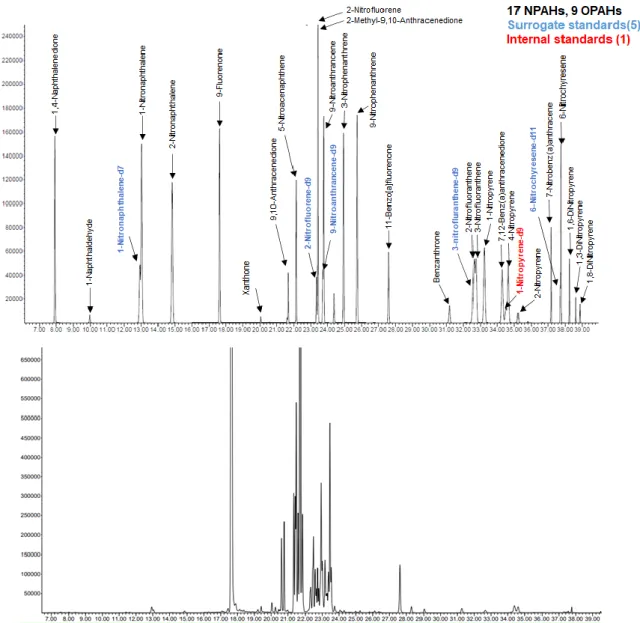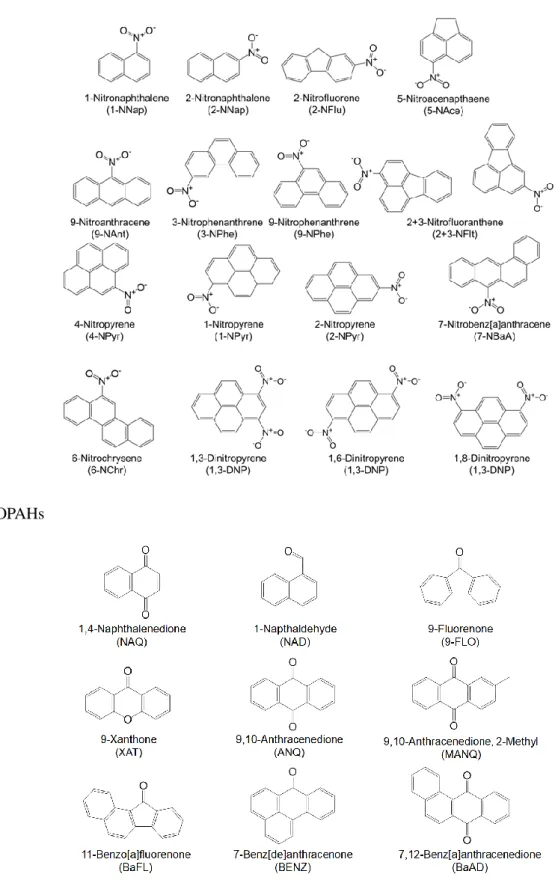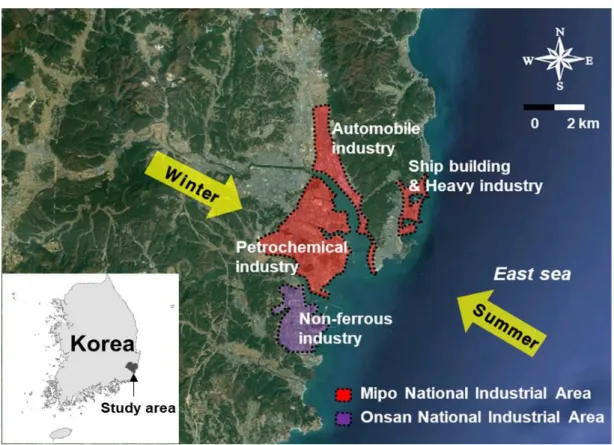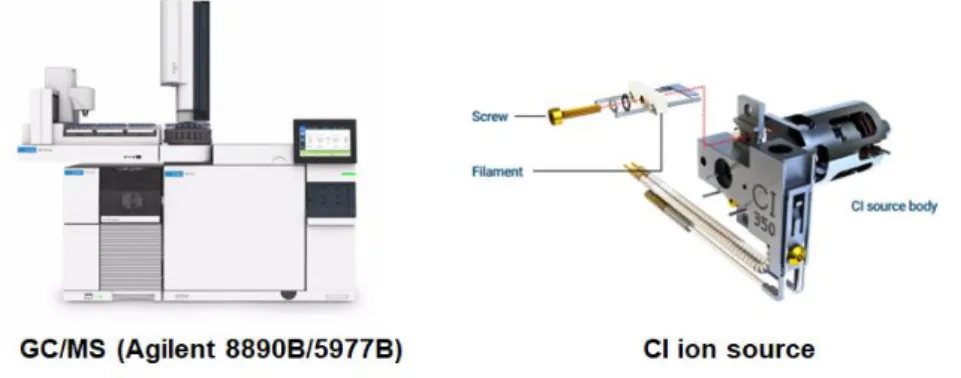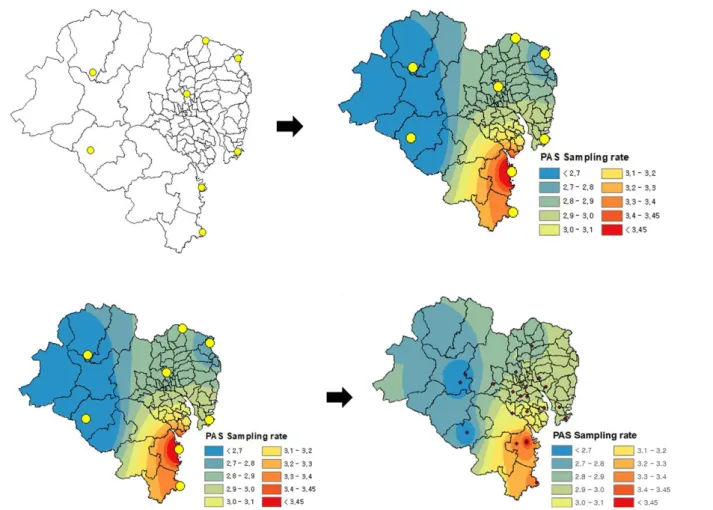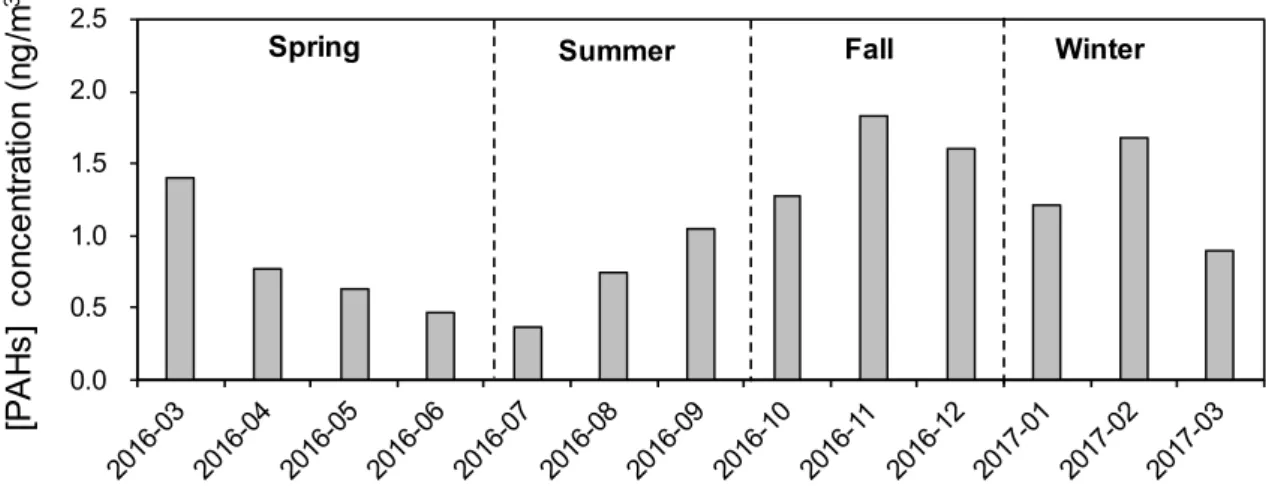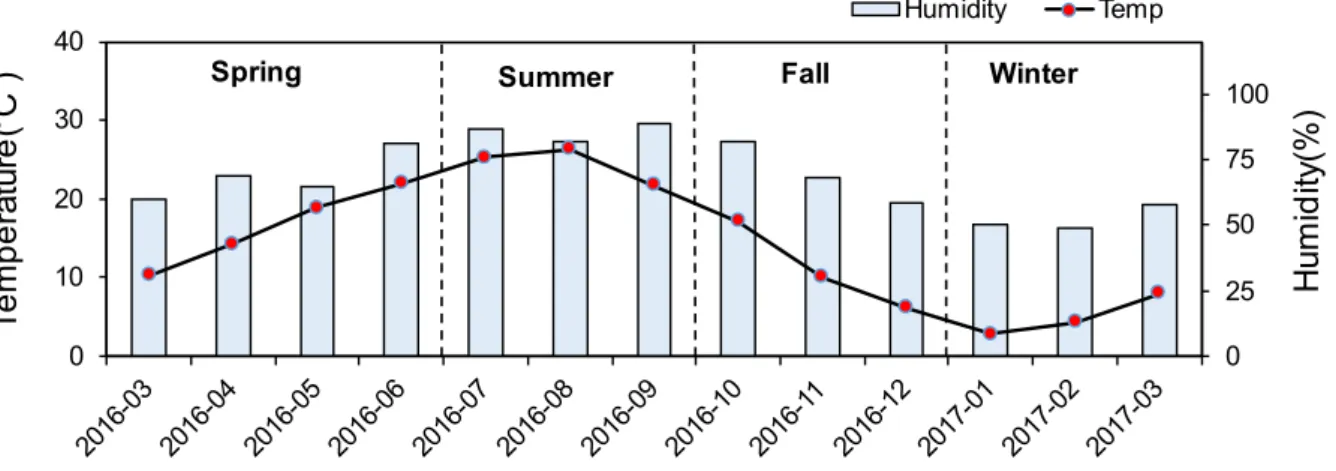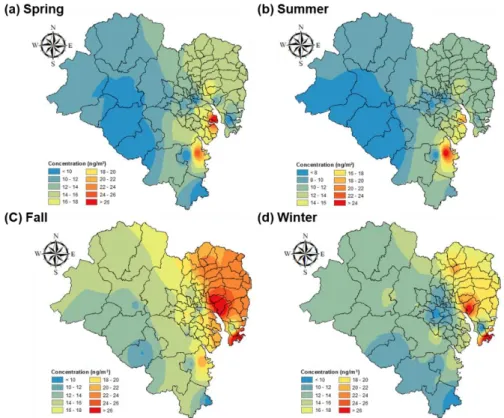Polycyclic aromatic hydrocarbons (PAHs) are ubiquitous toxic air pollutants that are mostly released through incomplete combustion along with PAH derivatives such as OPAHs and NPAHs. In addition, NOPAHs are also formed by secondary formation through the reaction between existing PAHs and atmospheric oxidants such as nitrate, ozone and OH radicals. In this study, the concentration level, seasonal and spatial variation, source-receptor relationship, and potential cancer risk of 21 PAHs, 9 OPAHs, and 17 NPAHs were investigated using passive air samplers (PAS) in Ulsan.
The spatial distribution confirmed that each target compound had different emission sources per season. PAHs are mainly emitted from petrochemical industrial and non-ferrous metal industrial complexes in the warm season, and from the automotive industrial complex in the cold season. As a result of the correlation analysis between PAHs and derived PAHs, there are significant positive correlations indicating that they were emitted from similar emission sources.
The emission sources and formation pathways of target compounds were investigated using the diagnostic ratio. Through the spatial distribution of risk, PAHs were higher in industrial complexes and NPAHs in non-ferrous metal industrial complexes.
Introduction
Therefore, to investigate the high-resolution spatial distribution and source-receptor relationship, it is necessary to conduct air monitoring on NOPAHs using passive air samplers in Korea. Active air samplers (AASs) or passive air samplers (PASs) are widely used to monitor atmospheric PAHs. However, it is expensive, requires electricity and is difficult to deploy in several locations at the same time.
In the case of NOPAHs, most of the research used AAS such as high/low-volume air samplers (>100m3) with polyurethane foam (PUF) to investigate atmospheric concentrations in different phases. However, there are few studies investigating NPAHs and OPAHs using polyurethane foam-based passive air samplers (PUF-PASs). Especially in Korea, there are few papers that studied PAHs, NPAHs, and OPAHs simultaneously, so it is necessary to understand pollution patterns in Korea.
Second, is the identification of source-receptor relationships in target compounds through diagnostic ratio and correlation analysis. Finally, it is to assess the cancer risk caused by exposure to the target compounds through inhalation and then compare by space.
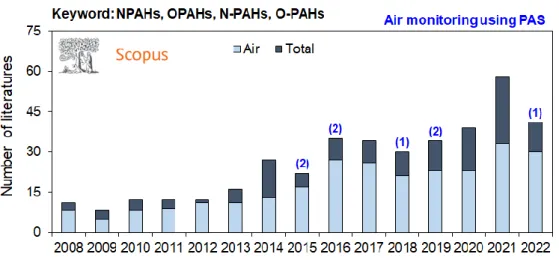
Material and Methods
- Chemicals and material
- Passive air sampling
- Analysis procedure and instrumental condition
- Quality assurance and Quality controls (QA/QC)
- Calculation of PAHs concentration in air
- Meteorological and criteria/hazardous air pollutant data
- Statistical tools
- Risk assessments
Before Soxhlet extraction (20 h, 350 mL of extraction solvent (n-hexane/acetone = 9:1 (v/v))), surrogate standards were added to the obtained PUF discs. Then, each concentrated extract was purified with 70 mL of eluent (n - hexane/dichloromethane = 9:1 (v/v)) for PAHs through silica gel columns (bottom and top layers: 2 g sodium sulfate, middle layer: .5 g silica gel). The eluents for PAHs were concentrated to 500 μL and the eluents for NOPAHs were concentrated to 200 μL using a Turvo-Vap and N2 vaporizer.
In this study, 24 PAHs, 9 OPAHs, and 17 NPAHs were analyzed using GC/MS-EI for PAHs and GC/MS-NCI for NOPAHs. Chromatograms of the standard and actual NOPAH sample analyzed by GC/MS-NCI are shown in Figure S1. Field and laboratory blank samples were collected (n = 8 and 9); The blanks were analyzed using the same procedure as the actual samples.
Average surrogate recovery rates for PAHs and NOPAHs ranged from 60% to 97% and are shown in Table 2. Therefore, the concentration of target compounds in air (CAir: ng/m3) should be calculated using Equation 2 below with the amount of sequestered compounds. on PUF disc (ng/PUF), sampling days and sampling rate of passive air samplers (Rs: m3/day). However, the sampling rate varies depending on the meteorological conditions and the physicochemical characteristics of the target compounds.
The Global Passive Atmospheric Sampling Network developed a new sampling rate prediction model using a MATLAB code with meteorological data (temperature, pressure, wind speed, wind direction and relative humidity) and physicochemical properties (MW: molecular weight, KOA: octanol- air partition coefficient and UOA: internal energy of transfer) (Herkert et al., 2016; Herkert et al., 2018). Meteorological data (temperature, pressure, wind speed, wind direction, and relative humidity) from an automated synoptic observing system (ASOS) and 7 automatic weather stations (AWS) were provided by the Korea Meteorological Administration (KMA, http ://www.data .kma.go.kr/). The potential cancer risk caused by inhalation of PAHs and NPAHs was estimated using the incremental lifetime cancer risk (ILCR) model.
Before calculating ILCR, measured concentrations were converted to the BaPeq concentration based on the toxicity equivalence factor (TEF) of PAHs and NPAHs. The potential cancer risks of target compounds were compared to an acceptable level by US-EPA. These values are generally recognized as acceptable levels when below 10-6 and severe levels causing cancer risk possibly above 10-6 for possibly causing cancer risk (Fewtrell & Bartram, 2001).
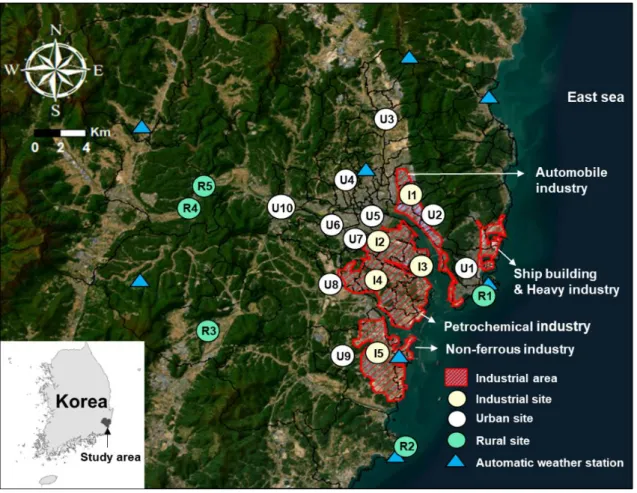
Results and Discussion
- Calculation of sampling rates
- Level of concentration of target compounds
- Spatial distribution
- Source identification
- Correlation analysis
- Diagnostic ratio
- Risk assessment
The average concentration of PAHs, OPAHs and NPAHs is similar to other studies (Table S2). Herein, the concentration of PAHs in the autumn was statically higher than the summer season (rank sum test: p<0.01). However, the concentration of PAHs was higher in autumn than in winter, which is thought to be due to overlapping sampling periods and each season.
In addition, the concentration of PAHs appeared to be higher in autumn than in winter, but there was no statistically significant difference. However, except for spring, there appears to be no difference in OPAH concentration by season. PAHs appeared to be mainly influenced by non-ferrous industrial complexes and petrochemical industrial complexes in the spring and summer.
On the other hand, PAH concentrations in autumn and winter were higher near the automotive industrial complex than near the petrochemical and non-ferrous industrial complexes. In autumn and winter, high concentrations appear in the R1 area, which is far from the influence of the automotive industrial complex. However, high concentrations of OPAHs were found in automotive industrial complexes in summer, and the impact of petrochemical complexes also appeared to be increased.
Unlike pPAHs, in the case of NPAHs it is difficult to separate specific emission sources due to the coexistence of the influence of the primary emission and secondary formation of the industrial complex rather than the influence of the seasonal wind direction. NO2 and O3 are known as the main atmospheric oxidants in the secondary photochemical reaction of NOPAHs (Zeng et al., 2020). In the previous paper, it is suggested that OPAHs are related to secondary formation when they have a negative correlation with NO2.
In previous studies, 9-FLO had higher concentrations in both the gas and particulate phases in ozone-free environments (Albinet et al., 2007; Nocun & Schantz, 2013). However, this ratio was high in the U1 area during summer, and the concentration of O3 was also high. In the case of NPAHs, the diagnostic ratio was identified to determine the effects of primary emission and secondary formation.
However, at the U10 site it shows a value of over 2 in autumn and winter. Apart from some samples at urban sites in spring, this implies that NPAHs are mainly formed by secondary formation.
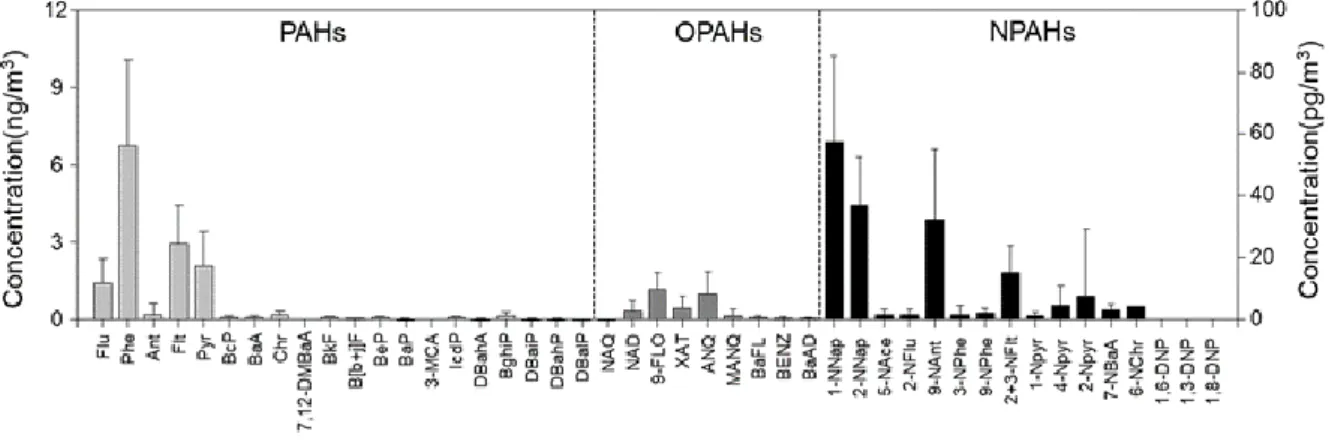
Conclusion
Nitrated and oxygenated derivatives of polycyclic aromatic hydrocarbons in the ambient air of two French Alpine valleys Part 1: Concentrations, sources and gas/particle partitioning. Polycyclic aromatic hydrocarbons (PAHs) and their derivatives (oxygenated PAHs, nitrated PAHs and azaarenes) in size-fractionated particles emitted in an urban road tunnel. Improving the spatial resolution of atmospheric polycyclic aromatic hydrocarbons using passive air samplers in a multi-industrial city.
Temporal trends in levels and patterns of polycyclic aromatic hydrocarbons (PAHs) in pine bark, litter and soil after a forest fire. Analysis of atmospheric concentrations of quinones and polycyclic aromatic hydrocarbons in vapor and particulate phases. Influence of secondary formation on atmospheric occurrences of oxygenated polycyclic aromatic hydrocarbons in airborne particles.
Concentrations and spatial distribution of polycyclic aromatic hydrocarbons (PAHs) and nitrate PAHs (NPAHs) in the atmosphere of northern China, and the transformation of PAHs to NPAHs. 5-linked polycyclic aromatic hydrocarbons (PAHs) and nitrate PAHs (NPAHs) in Harbin, a cold city in northern China. Spatial high-resolution monitoring and risk assessment of polycyclic aromatic hydrocarbons in an industrial city.
Determination of selected oxygenated polycyclic aromatic hydrocarbons (oxy-PAHs) in diesel standard reference materials and particulate matter (SRMs). Particle size distribution of nitrated and oxygenated polycyclic aromatic hydrocarbons (NPAHs and OPAHs) on traffic and suburban surfaces in a European megacity: Paris (France). Emissions of parent, nitro, and oxygenated polycyclic aromatic hydrocarbons from wood combustion in residential areas in rural China.
Seasonal variations and source distribution of oxygenated polycyclic aromatic hydrocarbons (OPAHs) and polycyclic aromatic hydrocarbons (PAHs) in PM2. Monitoring of polycyclic aromatic hydrocarbons using passive air samplers in Seoul, South Korea: spatial distribution, seasonal variation and source identification. Particulate emissions of parent polycyclic aromatic hydrocarbons (PAHs) and their derivatives (alkyl-PAHs, oxygenated PAHs, azaarenes and nitrated PAHs) from manually and automatically fired heating devices.
Passive air sampling of halogenated polycyclic aromatic hydrocarbons in the largest industrial city in Korea: Spatial distributions and source identification. 5-linked polycyclic aromatic hydrocarbons (PAHs) and their derivatives (nitrated-PAHs and oxygenated-PAHs) in a road tunnel located in Qingdao, China: Characteristics, sources and emission factors.
